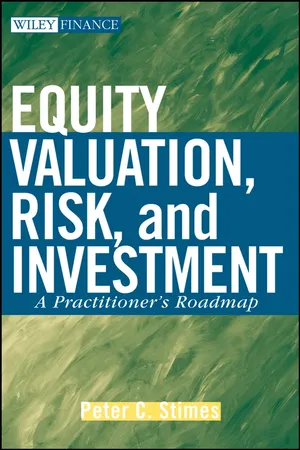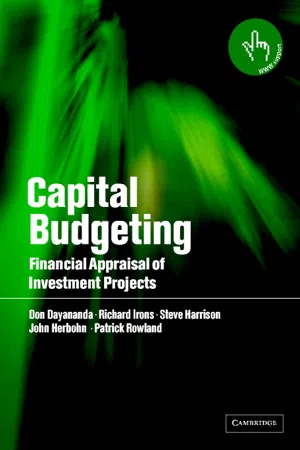Business
Growing Perpetuity Formula
The growing perpetuity formula is used to calculate the present value of an infinite series of cash flows that grow at a constant rate. It is commonly used in finance to determine the value of investments or business opportunities that generate a stream of cash flows expected to grow at a consistent rate indefinitely. The formula is expressed as PV = C / (r - g), where PV is the present value, C is the cash flow, r is the discount rate, and g is the growth rate.
Written by Perlego with AI-assistance
Related key terms
1 of 5
7 Key excerpts on "Growing Perpetuity Formula"
- eBook - PDF
- Robert Parrino, David S. Kidwell, Thomas Bates, Stuart L. Gillan(Authors)
- 2021(Publication Date)
- Wiley(Publisher)
In this case the cash flow stream is called a growing perpetuity . The formula to compute the present value for a growing perpetuity that begins next period (PVP) is as follows: PVP = CF 1 ____ i − g (6.6) As before, CF 1 is the cash flow occurring at the end of the first period, i is the discount or interest rate, and g is the constant rate of growth of the cash flow (CF). Equation 6.6 is an easy equation to work with, and it is used widely in the valuation of common stock for firms that have a policy and history of paying dividends that grow at a constant rate. It is also widely used in the valuation of entire companies, as we will discuss in Chapter 18. Notice that we can derive Equation 6.6 from Equation 6.5 by setting n equal to ∞. If i is greater than g, as we said it must be, the term [(1 + g)/(1 + i )] ∞ is equal to zero, leading to the following result: PVP = CF 1 ____ i − g × [ 1 − ( 1 + g _____ 1 + i ) ∞ ] = CF 1 ____ i − g × [1 − 0 ] = CF 1 ____ i − g This makes sense, of course, since Equation 6.5 describes a growing annuity and Equation 6.6 describes a growing cash flow stream that goes on forever. Notice that both Equations 6.5 and 6.6 are exactly the same as Equations 6.1 and 6.4 when g equals zero. To illustrate a growing perpetuity, we will consider an example. Suppose that, after graduating from college, you started a health and athletic club. Your concept included not only providing workout facilities, such as weights, treadmills, and elliptical trainers, but also promoting a healthy lifestyle through a focus on cooking and nutrition. The concept has proved popular, and after only five years, you have seven clubs in operation. Your accoun- tant reports that the firm’s cash flow last year was $450,000, and the appropriate discount rate for the club is 18 percent. You expect the firm’s cash flows to increase by 5 percent per year, which includes 2 percent for expected inflation. - eBook - PDF
- Peter Moles, Robert Parrino, David S. Kidwell(Authors)
- 2014(Publication Date)
- Wiley(Publisher)
It is also widely used in the valuation of entire compa- nies, as we will discuss in Chapter 18. CHAPTER 6 DISCOUNTED CASH FLOWS AND VALUATION 223 Growing perpetuity a cash flow stream that grows at a constant rate forever Notice that we can easily derive Equation (6.7) from Equation (6.6) by setting n equal to 1. If i is greater than g, as we said it must be, the term [(1 þ g)/(1 þ i)] 1 is equal to 0, leading to the following result: PVA 1 ¼ CF 1 i g 1 1 þ g 1 þ i 1 ¼ CF 1 i g 1 0 ½ ¼ CF 1 i g This makes sense, of course, since Equation (6.6) describes a growing annuity and Equation (6.7) describes a growing cash flow stream that goes on forever. Notice that Equations (6.6) and (6.7) are exactly the same as Equations (6.1) and (6.4) when g equals zero. To illustrate a growing perpetuity, we will consider an example. Suppose that you and a partner, after graduating from university, started a health and athletic club. Your concept included not only providing workout facilities, such as weights, treadmills and elliptical trainers, but also promoting a healthy lifestyle through a focus on cooking and nutrition. The concept has proved popular and after only five years you have seven clubs in operation. Your accountant reports that the firm’s cash flow last year was D 450 000 and the appropriate discount rate for the club is 18%. You expect the firm’s cash flows to increase by 5% per year, which includes 2% for expected inflation. The business has no fixed life, so you can assume it will continue operating indefinitely into the future. What is the value of the firm? We can use Equation (6.7) to solve this prob- lem. Although the equation is very easy to use, a common mistake is using the current period’s cash flow (CF 0 ) and not the next period’s cash flow (CF 1 ). Since the cash flow is growing at a constant growth rate, g, we simply multiply CF 0 by (1 þ g) to get the value of CF 1 . - eBook - ePub
Corporate Valuation
Measuring the Value of Companies in Turbulent Times
- Mario Massari, Gianfranco Gianfrate, Laura Zanetti(Authors)
- 2016(Publication Date)
- Wiley(Publisher)
We now consider the scenario of perpetual growth in real terms. To simplify the analysis, we will refer to a no-inflation scenario.Growth models are presented in every finance book and wherever valuation and securities analysis are discussed because they allow for the simplification of many problems. They are also the basis to analyze more complex models that will be presented later. Growth formulas are also used in other chapters, where we discuss opportunity cost of capital estimates based on current stock prices and theory of multiples.The perpetual growth model can be useful to value a business when the business model and the industrial context are such to believe that the cash flow will grow in the long term (at least 20 to 30 years). Therefore, it is better to apply this method to industries that grow in line with the whole economy (e.g. utility companies). Alternatively, it is better to use models based on limited growth assumptions.10.3.1 Perpetual Growth Model for Unlevered Companies
The perpetual growth model applied to unlevered businesses, that is, to companies with no debt, is known as the Gordon model, named after Myron Gordon, the person who spread its use in the United States of America during the 1950s and 1960s.6The formula to compute the value of an unlevered company can be presented as follows (notice that when there is no debt, the FCFO and the FCFE coincide):Let us use an example to better discuss its meaning. Assume that the income statement of a company is:10.5- EBIT
2,500 - Interests
0 - Taxes (37%)
(925) - Net income
1,575 The cash flow dynamic is shown in Exhibit 10.5 . The dashed line parallel to the horizontal axis shows the net cash flow of the business available to shareholders (FCFE) in a steady-state scenario. The flow is equal to 1,575 from - Pablo Fernandez(Author)
- 2002(Publication Date)
- Academic Press(Publisher)
PART III Rigorous Approaches to Discounted Cash Flow Valuation This Page Intentionally Left Blank Chapter 17 Discounted Cash Flow Valuation Methods: Perpetuities, Constant Growth, and General Case 17.1. INTRODUCTION This chapter explores the discounted cash X ow valuation methods. We will start the chapter with the simplest case: no-growth, perpetual-life companies. Then we will study the continuous growth case and, W nally, the general case. The di V erent concepts of cash X ow used in company valuation are de W ned: equity cash X ow ECF), free cash X ow FCF), and capital cash X ow CCF). Then the appropriate discount rate is determined for each cash X ow depending on the valuation method used. Our starting point will be the principle by which the value of a company's equity is the same, whichever of the four traditional discounted cash X ow formulae is used. This is logical: given the same expected cash X ows, it would not be reasonable for the equity's value to depend on the valuation method. Initially, it is assumed that the debt's market value D) is equal to its book value N). 1 Section 17.5 discusses the case in which the debt's book value N) is not equal to its market value D), as is often the case, and Section 17.6 analyzes the impact of the use of simpli W ed formulae to calculate the levered beta. Section 17.7 addresses the valuation of companies with constant growth, and Section 17.11 discusses the general case in company valuation. 375 1 This means that the required return to debt Kd) is equal to the interest rate paid by the debt r). 17.2. COMPANY VALUATION FORMULAE, PERPETUITIES The cash X ows generated by the company are perpetual and constant there is no growth). The company must invest in order to maintain its assets at a level that enables it to ensure constant cash X ows: this implies that the book depreciation is equal to the replacement investment. We will start with a numerical example, to help the reader become familiar with the concepts.- eBook - PDF
- Robert Parrino, David S. Kidwell, Thomas Bates(Authors)
- 2016(Publication Date)
- Wiley(Publisher)
perpetuity A series of level cash flows that continue forever. ordinary annuity An annuity in which payments are made at the ends of the periods. WEB Visit the following webform that provides an online annuity calculator http://www.feike.biz/annuity.php Present Value of an Annuity We frequently need to find the present value of an annuity (PVA) . Suppose, for example, that a financial contract pays €2 000 at the end of each year for three years and the appropriate discount rate is 8 per cent. The time line for the situation is: 3 Year 2 1 0 8% € 2 000 € 2 000 € 2 000 PV = ? What is the most we should pay for this annuity? Of course, we have worked problems like this one before. All we need to do is calculate the present value of each individual cash flow present value of an annuity (PVA) The present value of the cash flows from an annuity, discounted at the appropriate discount rate. 6.2 Level Cash Flows: Annuities and Perpetuities 187 (CF ) n and add them up. Using Equation 5.4, we find that the present value of the three-year annuity (PVA ) 3 at 8 per cent interest is: = × + ⎡ ⎣ ⎢ ⎤ ⎦ ⎥ + × + ⎡ ⎣ ⎢ ⎤ ⎦ ⎥ + × + ⎡ ⎣ ⎢ ⎤ ⎦ ⎥ = × ⎡ ⎣ ⎢ ⎤ ⎦ ⎥ + × ⎡ ⎣ ⎢ ⎤ ⎦ ⎥ + × ⎡ ⎣ ⎢ ⎤ ⎦ ⎥ = + + = i i i P VA CF 1 1 CF 1 (1 ) CF 1 (1 ) €2 000 1 1.08 €2 000 1 (1.08) €2 000 1 (1.08) €1 851.85 €1 714.68 €1 587.66 €5 514.19 3 1 2 2 3 3 2 3 This approach to computing the present value of an annuity works as long as the number of cash flows is relatively small. In many situations that involve annuities, however, the number of cash flows is large, and doing the calculations by hand would be tedious. For example, a typical 30-year home mortgage has × 360 (12 months 30 years) monthly payments. Fortunately, our problem can be simplified because the cash flows (CF) for an annuity are all the same = = = (CF CF . . . CF CF) n 1 2 . - eBook - ePub
Equity Valuation, Risk, and Investment
A Practitioner's Roadmap
- Peter C. Stimes(Author)
- 2011(Publication Date)
- Wiley(Publisher)
3.16 ), which contains the valuation formula for a nonleveraged, perpetual cash flow stream for a growth company.)First, defineUnder these assumptions, we obtain:Xi,jas the cash flow in period j associated with an investment made at time i , where j ≤ i. If i = 0, thenX0,jrepresents the net operating cash flow from cumulative investments made at or before time zero. Starting with these, we assume that they grow at the rate of inflation, π, until the end of H periods, at which time operating cash flows cease.(3.1)and so on, which recursively produces:(3.2)While this seems easy enough, we next have to define the amount of cash that is reinvested and the amount and timing of the operating cash flow that is subsequently produced. We posit that investment opportunities, defined asWe need to see a few things clearly. First, we need to realize thatIN ,represent a constant fraction of after-tax cash flows from operations, f. Further, we posit that an investmentINproduces a cash flow in the next year of z ·IN· (1 + π) that subsequently rises with the underlying inflation rate for H periods until the cash flow ceases. We can regard z as the real return on equity (ROE) or, alternatively, the real coupon flow from reinvested operating cash flow.(3.3)and that(3.4)and, finally, that(3.5)The calculation becomes computationally involved, as Table 3.1 shows. However, the table also shows that, because of the recursive nature of these formulas, things streamline very well. Table 3.1 starts with an annualized operating cash flow at time zero of X 0,0 - eBook - PDF
Capital Budgeting
Financial Appraisal of Investment Projects
- Don Dayananda, Richard Irons, Steve Harrison, John Herbohn, Patrick Rowland(Authors)
- 2002(Publication Date)
- Cambridge University Press(Publisher)
For the first nine years the project does not generate any cash inflow. For the next 84 Capital Budgeting eleven years (i.e. from the tenth to the twentieth years inclusive), it generates $60 per year. The discount rate is 10% per annum. What is the present value of this project’s cash inflows? Workbook 5.12 PV = 60 × 1 − (1 . 1) − 11 0 . 1 × 1 . 1 − 9 = 60 × 6 . 4951 × 0 . 4241 = $165 . 27 To understand this properly, recalculate this using the formula for the present value of a series of individual future cash flows: PV = 0 (1 . 1) + 0 (1 . 1) 2 + 0 (1 . 1) 3 + 0 (1 . 1) 4 + 0 (1 . 1) 5 + 0 (1 . 1) 6 + 0 (1 . 1) 7 + 0 (1 . 1) 8 + 0 (1 . 1) 9 + 60 (1 . 1) 10 + 60 (1 . 1) 11 + 60 (1 . 1) 12 + 60 (1 . 1) 13 + 60 (1 . 1) 14 + 60 (1 . 1) 15 + 60 (1 . 1) 16 + 60 (1 . 1) 17 + 60 (1 . 1) 18 + 60 (1 . 1) 19 + 60 (1 . 1) 20 = 0 + 0 + · · · + 0 + 23 . 13 + 21 . 03 + 19 . 11 + 17 . 38 + 15 . 80 + 14 . 36 + 13 . 06 + 11 . 87 + 10 . 79 + 9 . 81 + 8 . 92 = $165 . 26 This is the same answer as obtained by using the deferred annuity formula. Perpetuity A perpetuity is a special case of an annuity in which the number of equal cash flows is infinite. Because the cash flows go on forever, we cannot calculate the future value of a perpetuity; a perpetuity does not have an end of life. Hence, a future value cannot be calculated. The formula for the present value of a perpetuity is: PV = C t r This formula is adapted from the annuity formula used in Example 5.10, which is repeated here: PV = C r 1 − 1 (1 + r ) n In a perpetuity, n is infinite. In the limit, as n approaches infinity, 1 (1 + r ) n approaches zero, so the overall equation becomes PV = C r . Essential formulae in project appraisal 85 The application of this formula is straightforward and does not require an example. Net present value The net present value (NPV) of a project is calculated by subtracting the present value of the capital outlays from the present value of the cash inflows.
Index pages curate the most relevant extracts from our library of academic textbooks. They’ve been created using an in-house natural language model (NLM), each adding context and meaning to key research topics.






